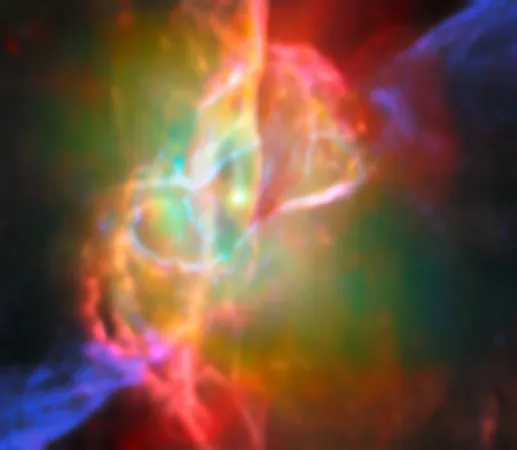
James Webb Telescope Unveils Secrets of the Cosmic Butterfly Nebula
2025-08-28
Author: Kai
A Cosmic Marvel Revealed
The James Webb Space Telescope (JWST) has uncovered stunning new details within the core of the Butterfly Nebula, also known as NGC 6302. Known for its breathtaking beauty, this nebula, located roughly 3,400 light-years away in the constellation Scorpius, has been a focal point of astronomical studies. With fresh observations, Webb presents a dynamic and intricate portrait of this celestial wonder.
Understanding Planetary Nebulas
Planetary nebulas, among the most exquisite phenomena in the universe, are formed when stars with masses between 0.8 and 8 times that of our Sun exhaust their nuclear fuel and shed their outer layers in a spectacular finale. However, the term ‘planetary’ is misleading; these structures have little to do with planets, a naming error dating back to early astronomers who noted their round appearance. The Butterfly Nebula debunks this stereotype with its asymmetric, striking form.
The Fascinating Structure of the Butterfly Nebula
The Butterfly Nebula exhibits a unique bipolar structure, featuring two lobes that extend outward like butterfly wings, with a dark, dusty band forming its central body. This band is a torus that obscures the star at the nebula's center. This ancient, Sun-like star is a vigorous source of energy, causing the nebula to emit a mesmerizing glow, further enhanced by the dust that shapes its ethereal structure.
Groundbreaking Observations from Webb
The latest images from Webb, particularly from its Mid-InfraRed Instrument (MIRI), deliver an unprecedented glimpse into the nebula’s nuances. By capturing data across various wavelengths simultaneously, researchers have detected nearly 200 spectral lines, each revealing insights into the nebula’s complex chemistry and structure. Notably, scientists have finally located the elusive central star, enshrouded in dust and previously hidden from optical observations.
Brilliantly Hot and Incredibly Complex
With a scorching temperature of 220,000 Kelvin, this central star is one of the hottest known to exist within a planetary nebula. Its intense energy is both mesmerizing and revealing, as it interacts with the surrounding dust torus—composed of crystalline silicates and larger-than-usual dust particles. This dense band may funnel the star’s energy, contributing to the nebula's spectacular glow.
An Unexpected Discovery: PAHs in the Nebula
In a groundbreaking revelation, researchers identified carbon-based molecules called polycyclic aromatic hydrocarbons (PAHs) within the nebula. These substances, often found in everyday combustion sources on Earth, may provide vital insights into chemical processes in space, signifying a potential location for PAH formation in oxygen-rich environments.
Join the Cosmic Adventure!
JWST continues to unlock the mysteries of our universe, revealing the complex interplay of light, matter, and molecular chemistry within the Butterfly Nebula. The findings, published in the Monthly Notices of the Royal Astronomical Society, represent a significant leap in our understanding of such heavenly bodies. As we gaze deeper into the cosmos, who knows what other secrets await? Stay tuned for cosmic adventures ahead!




 Brasil (PT)
Brasil (PT)
 Canada (EN)
Canada (EN)
 Chile (ES)
Chile (ES)
 Česko (CS)
Česko (CS)
 대한민국 (KO)
대한민국 (KO)
 España (ES)
España (ES)
 France (FR)
France (FR)
 Hong Kong (EN)
Hong Kong (EN)
 Italia (IT)
Italia (IT)
 日本 (JA)
日本 (JA)
 Magyarország (HU)
Magyarország (HU)
 Norge (NO)
Norge (NO)
 Polska (PL)
Polska (PL)
 Schweiz (DE)
Schweiz (DE)
 Singapore (EN)
Singapore (EN)
 Sverige (SV)
Sverige (SV)
 Suomi (FI)
Suomi (FI)
 Türkiye (TR)
Türkiye (TR)
 الإمارات العربية المتحدة (AR)
الإمارات العربية المتحدة (AR)